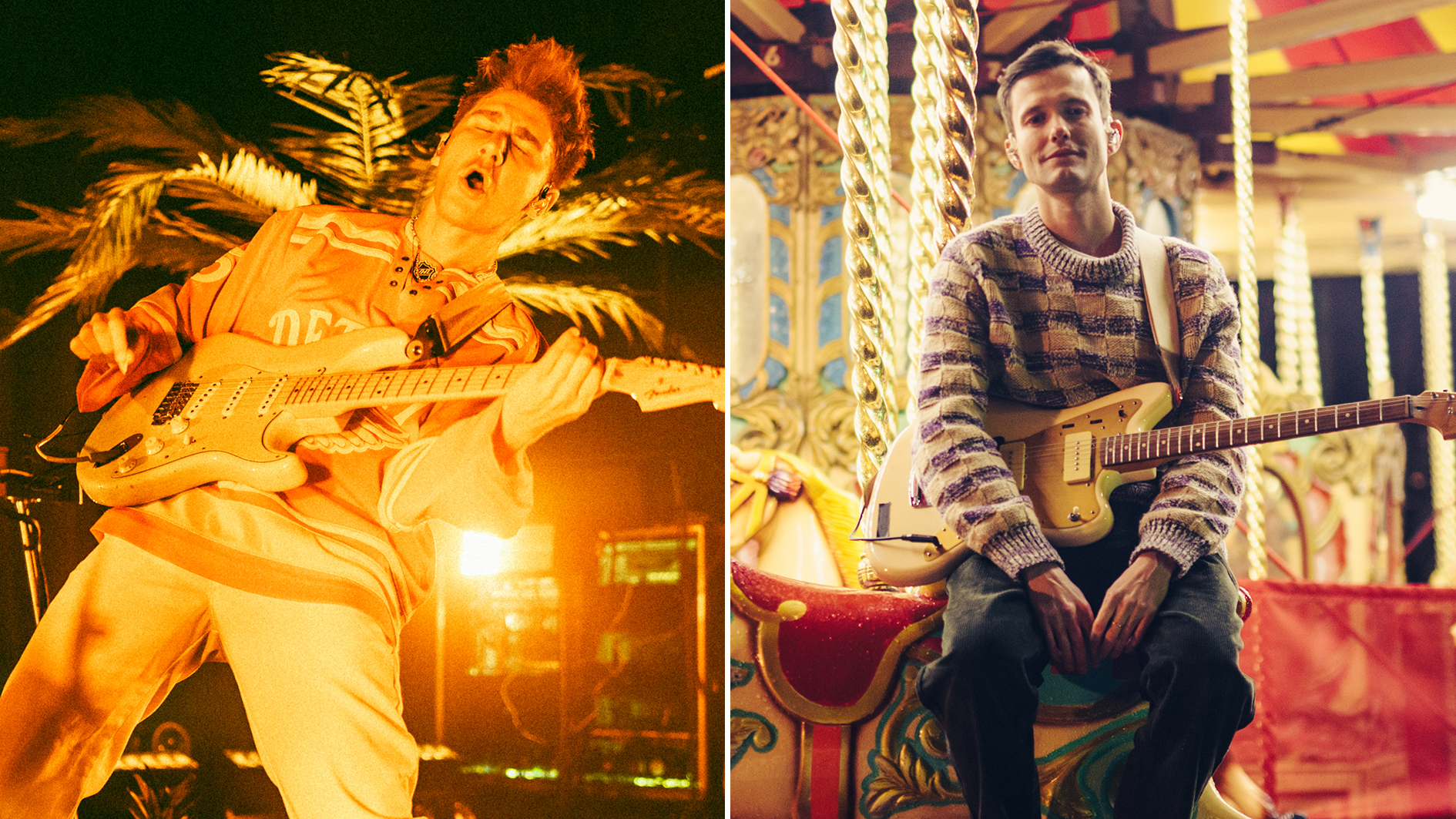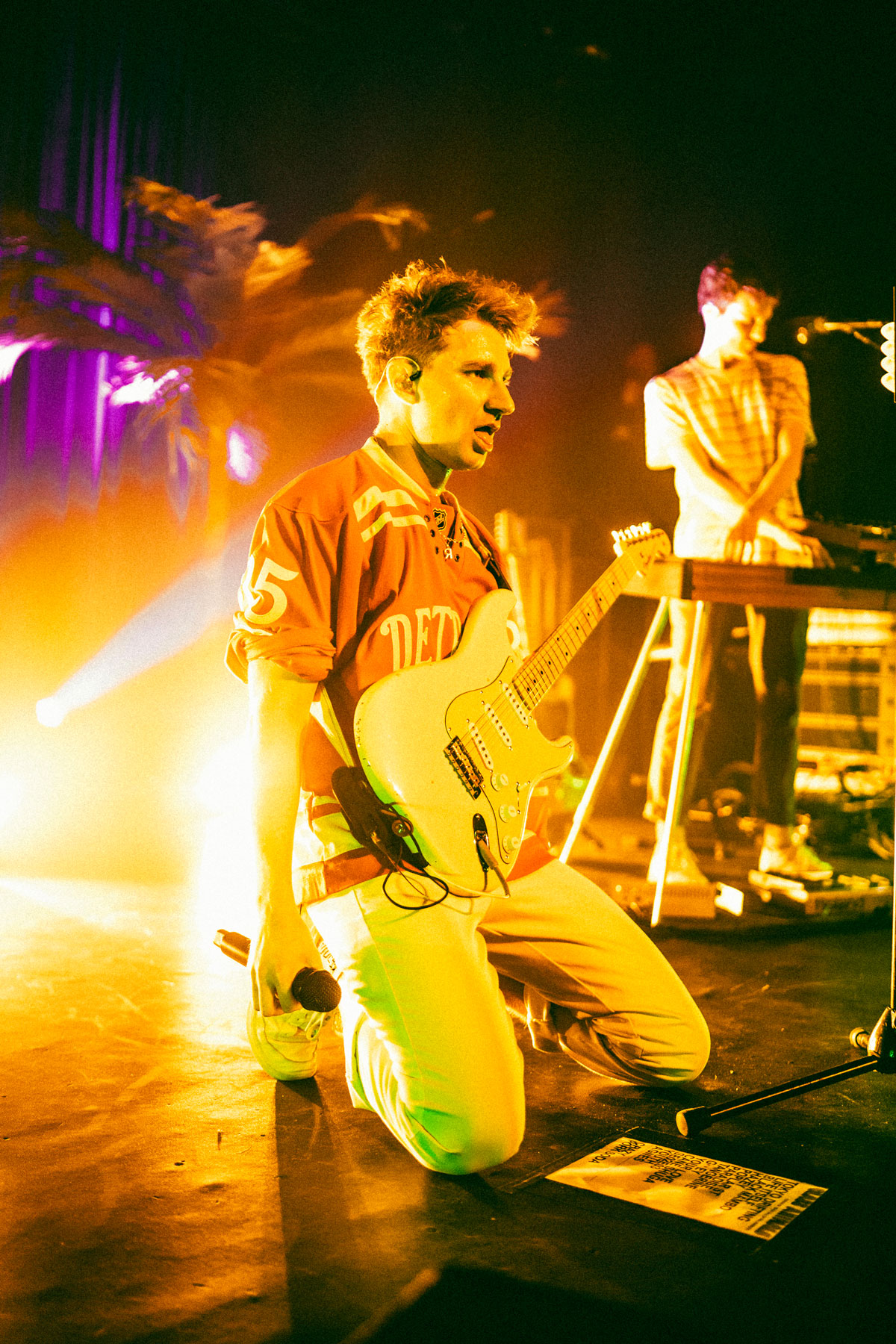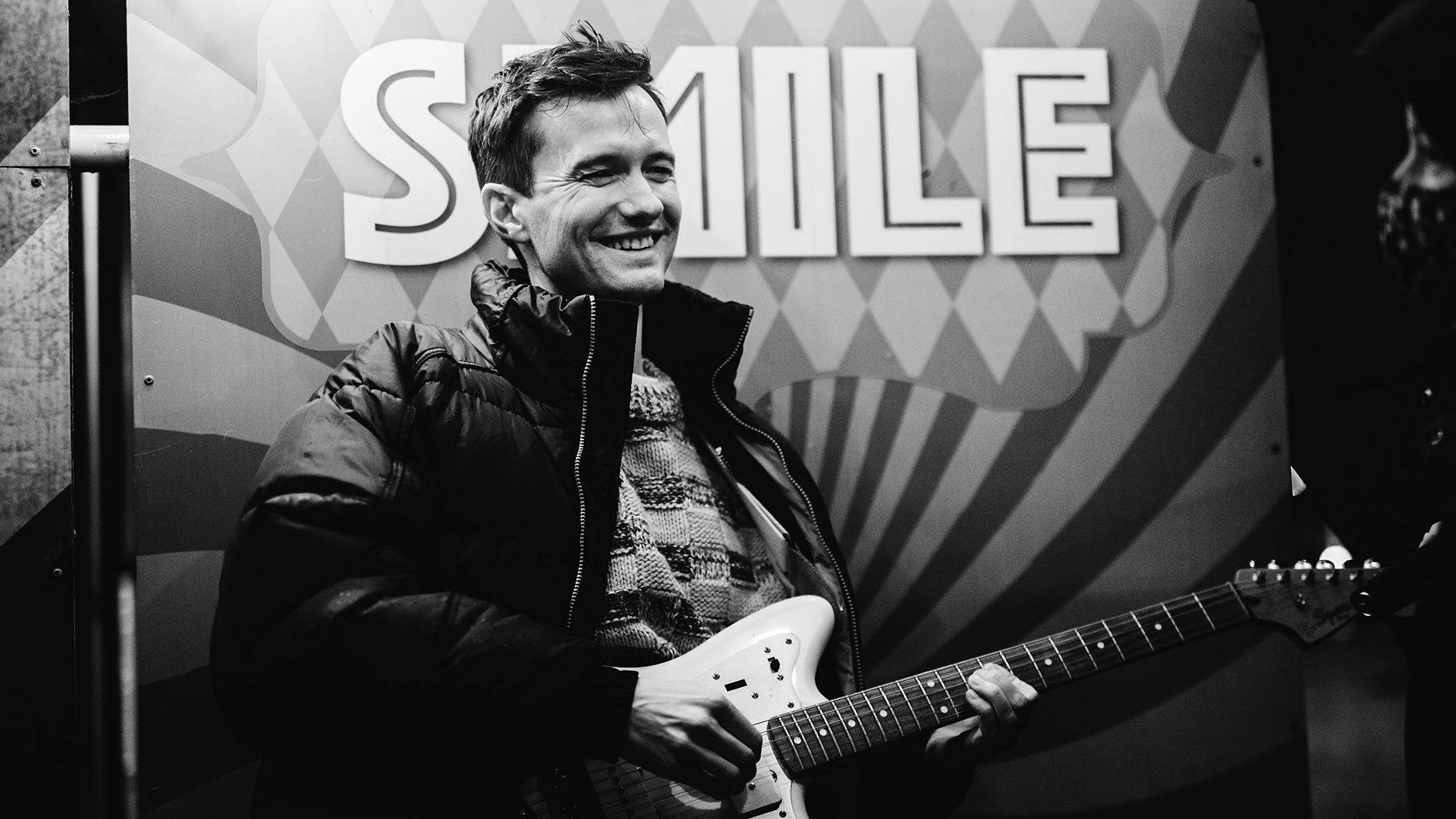Glass Animals: “You shouldn't limit yourself. To get new sounds out of the guitar you have to push it”
The UK psych-pop outfit explore the guitars, amps, basses and effects behind hugely successful latest album, Dreamland

UK quartet Glass Animals mix contemporary beats, inventive and skillful production techniques, and an old-school psychedelic, almost post-punk, experimental vibe to create a swirling stew of sonic playfulness that sucks you in upon first listen.
Their latest album Dreamland uses singer/guitarist Dave Bayley’s reminiscences about his childhood as well as '90s and early-2000s popular culture as a jumping-off point to explore various topics both life affirming and harrowing. The tracks are linked with sound snippets recorded via camcorder by Bayley’s mother during the songwriter’s Texas childhood.
Heat Waves – the ear-wormy single off the album with over 300 million global streams – recently hit number one on Billboard’s Alternative Airplay chart and landed them an appearance on The Tonight Show in the US.
The band are also very engaged with their fan community, inviting them to contribute artwork and ideas and regularly posting the results on social media.
Guitar World sat down over a video call with Bayley and guitarist Drew MacFarlane to chat about songwriting, gear both new and vintage, and the various ways you can manipulate sound these days by marrying computers with acoustic instruments to perform some musical sleight-of-hand.
Dave, talk a little about your songwriting process. Is it true you still use the nylon-string guitar you bought when you were a teenager? Do you like to work out riffs and a melody or chord sequences and do lyrics come after?
Bayley: “[holding up battered classical guitar] It usually starts with me playing some chords and then sometimes I’ll already have a turn of phrase in my head or an idea of what I want to write about.
Get The Pick Newsletter
All the latest guitar news, interviews, lessons, reviews, deals and more, direct to your inbox!
“Or, I want to make a song about 'this' situation or 'this' part of life and I'll think about what chords would work for that. I kind of hear things and work out what works for the sentiment of the songs and play chords that tell the story I want to tell. Then, I start mumbling some words or a couple of phrases over the top until there's a vocal melody there.
“Sometimes I'll leave it at that point and then finish the lyrics later after I've got all the melodies but sometimes the lyrics just come out. That's been happening more and more lately that the lyrics just kind of come out as I start doing the melodies and the production.”
On record at least, Glass Animals are not an obvious guitar band, but I’m guessing there’s quite a bit more guitar on Dreamland than seems on first listen because the parts get treated in various ways. I hear arpeggiated guitar lines on Melon and the Coconut and Waterfalls Coming Out Your Mouth.
Bayley: “Definitely. I'm completely untrained in every single way. I've learned off of trying to copy my favorite songs and I have no technique, no proper technique, or anything.
Those Rage Against The Machine riffs even sound heavy when you play them on a nylon-string guitar – that was always my mentality
Dave Bayley
MacFarlane: “You know what, I've had piano lessons, but I never got formally taught how to play the guitar. I started off with an acoustic guitar as a teenager and my dad taught me finger-picking styles of chords.
“So that's all that I ever did and genuinely the first time that I ever held a pick was when we started doing Glass Animals gigs, and then I was like 'how do you use this thing?'
“But then, obviously, you get used to it quickly. But I started off totally finger-picking and now it's more a mix of stuff but the Heat Waves riff, which Dave wrote but I play live, that's finger-picking.
Bayley: “There's a lot of arpeggiated stuff and it's very rarely big chords. Partly because when you're writing that leaves more space for vocals and also I lose all my picks all the time, and you don't need anything if you finger-pick!
“There was a Tom Morello thing I remember reading very early when I was just starting guitar – and the reason I kind of got this classical guitar was because he said that if you can write something on a Spanish guitar and it sounds big then just imagine how it's going to sound once you put it through your amps, your pedals, or whatever.
“Those Rage Against The Machine riffs even sound heavy when you play them on a nylon-string guitar. So, that was always my mentality.
“But we don’t really have 'riffs'. Maybe something like Space Ghost Coast To Coast has a kind of riff, doesn't it? I've always been interested in using technology alongside guitar playing.
“A lot of the sounds that you think are probably synths on the records are actually guitars or guitars blended with other things. Sometimes I blend them with vocal hums… that's what the Space Ghost riff is.
“Even the bass line in Space Ghost is actually just my classical guitar but pitched down an octave, and that stuff is really easy to do on the computer. You can pitch things up and down really quickly and you can kind of comp guitar takes and do things that are virtually impossible to do with your fingers.”
Dave, do you still have and play your Hofner Galaxie 175, and is that mostly a live guitar or do you use that to compose sometimes? I think I’ve seen you with a DiPinto as well.
Bayley: “Yeah, I think I have three Hofner Galaxies in this room. My favorite Hofner Galaxie is put away because it keeps falling apart and I have to keep sacrificing these other ones to put it back together again because they're essentially just made of balsa wood.
“Part of the reason I love them is because they’re so light. Do you know a band called The Kills? I was a huge Kills fan, and I remember Jamie Hince used to play one. I saw them live and I was like, 'That's the fucking coolest sounding guitar I've ever seen' and went to Denmark Street [London] and hunted one down like a week later.
“The number of sounds you can get out of it is incredible. I don't really like super-sustained guitar sounds and there’s a dampener on it that allows me to mute without using my palm. The neck’s quite thin, and it's not that easy to solo on so I got a DiPinto guitar because it’s really flat and I can solo a lot higher on the neck.
“And for bass guitar I just do everything on my Hofner 500. Ed (Irwin-Singer), our bass player, has started modifying some of those old Hofner basses because they’re breaking all the time and the controls suck tone. He’s a wizard; he’s fixed it so they don’t suck your tone anymore.
Good amps are expensive sometimes; we didn't always have the best recording equipment until recently
Dave Bayley
“It's got such a sound, and I started playing a lot of guitar parts on it and then pitching them up. So a lot of what you hear on the record is actually the 500 pitched up an octave to make it sound like a guitar riff and conversely, a lot of the basslines you hear are guitars pitched down an octave. It gives it this kind of fuzzy thump.”
And Drew I’ve seen you play what looks like a Fano JM6. What tones are you looking for in a guitar?
MacFarlane: “That's right. I've had that from the beginning. It's a JM6. Early on we were in a studio and I found a Jazzmaster, and I just really loved the shape of the body.
“The Fano I’ve got has that sort of body shape, but they kind of put together a lot of different parts from older guitars, sort of like classic pieces. It just feels really good to play, and I've never really wanted to change.
“I've just kind of stuck with it! It's super-versatile. It can really cut through when you want it to and have a sort of nasally, punchy sound. I’ve got P-90 pickups on it, which are really good for that. But you can also do more mellow rhythm stuff with it. So, it's super handy for everything.”
When you record, do you re-amp or use external effects? I hear a fair amount of tremolo on the guitars on some tracks. What are your physical amp preferences?
Bayley: “The first album, Zaba, was very much recording out of the amp and leaving it as it was in-the-box. The second album there was a lot more going on in the computer. Dreamland was kind of a combination of the two.
“Good amps are expensive sometimes; we didn't always have the best recording equipment until recently, but I basically just use these two amps – a Fender ’57 Custom Deluxe and a WEM Dominator.
“I also have an old Laney, and it's the best-sounding amp I've ever found in the world, but I keep blowing it up for some reason. It blows up more easily than most, I'd say, but is the most gorgeous-sounding thing. But the Fender ’57 Deluxe will do pretty much whatever you want.”

I’ve also heard you are a fan of various Universal Audio plug-ins, including the Fender ’55 Tweed Deluxe.
Bayley: “The UAD stuff is just so convenient. The fact that you can take this little box with you and basically have any guitar amp you want. So, I do use that loads, and we even use that live now. We used to use Fender Custom Twins live and now we've kind of swapped over to UAD stuff live just because of the versatility.
“We can push a button and just… 'bam', you’ve got a new amp, a new preset, and new pedals. You can EQ it how you want. It's the same every night when you're touring every single night instead of having the valves fall out in the truck!“
Do you use Ableton Live?
Bayley: “Yeah, we still use Ableton. It's an incredibly powerful program and you can host your amps in it. We actually just use the UAD live racks, so that's out of Ableton, actually, for the guitar amps. They’re so versatile. And I don't think we even use any pedals anymore, Drew?”
MacFarlane: “No. It was quite a radical shift between album two and album three with the live show.
“To begin with, we were totally analog and we'd run guitars into pedalboards and amps. Then after the How to Be a Human Being tour we went to wireless guitar packs, which go into the UAD racks, which have amp emulation and pedal emulation and then that goes into Ableton which has more pedal emulation and more effects. It's a good system because you get rid of any kind of problems with stage sound that comes from amps.
“That was always a big difficulty we had and it also means, as Dave says, it gives you huge versatility. You can make any kind of sound with any kind of effects that you want.”
Are there any latency issues because you're running so much through the computer?
MacFarlane: “Latency was always the issue we had with running guitars into computers and playing live. But recently, I think that because Ed, who we were talking about before, he's set up this live system for us and we split a lot of the processing between the UAD live racks, which actually do the digital signal processing in the unit.
“You can add a couple more things onto Ableton and the UAD has pretty fast processing power. So, overall the latency is low. It's really good. Technology finally caught up.”

Talk a little bit about your effect preferences for guitars whether they’re stompboxes or plug-ins.
Bayley: “There's loads. I use a Maestro Rhythm ‘N Sound which is actually a drum machine that you can plug your guitar into and you can push a button and play your bass pattern and then you can push another and play your snare. It's an incredible bit of kit.
“And then for pedals I use a Keeley Compressor and an Ibanez Tube Screamer. My favorite wah is the Mad Professor Snow White Auto Wah. An Electro-Harmonix Pitch Fork and Boss Harmonist for pitch shifting and also an MXR Carbon Copy delay.
“I really like the Analog Man vibratos, but they’re not worth taking on tour because they’re like unicorns today. I also have a JHS Crayon that just mimics desk distortion if you turn your preamp way too loud. Then there's all the 'in-the-box' computer stuff. It's another layer of stuff.
Sometimes when you're recording in-the-box it just doesn't sound real and then as soon as you put it out through an amp there’s this three-dimensionality that makes it sound a little bit more human
MacFarlane: “Yeah. The amp emulator that we're using is the UAD Fender Tweed Deluxe, and then we're also using Tube Screamer and Space Echo delay emulations and also an ADA chorus. And a Moog filter for filter effects.
“The cool thing about it is that you can also use things that are more like studio effects in your live rack or in Ableton. We use things like compressors and the UA 1176 Compressor is something that we tend to put on a decent bit of stuff.
“And also, come to think of it, for some of the pitch-shifting stuff that we do live we use an emulation of a DigiTech Whammy pedal. I can't remember who made it, but we found one that was good.
Bayley: “I’ve also got a Mellotron. There's a great guitar sound in the Mellotron – very plucky. And then there’s all the outboard gear, getting the right microphones and things, that’s a big part of it, and getting the right amp/mic technique like using Neumann U47s and pulling them back a little bit from your bass cabinet and actually even using sub-bass sounds, 808s.
“That really did involve a lot of re-amping through an Ampeg B-15 or again through the Fender. Yeah, re-amping and then just using the microphones they would have used on Motown records to get that warmth.
“Sometimes I feel like when you're recording in-the-box it just doesn't sound real and then as soon as you put it out through an amp and through some outboard gear there’s this three-dimensionality that makes it sound a little bit more human. There's something about those speaker cones vibrating the air.
“Ultimately, it’s just trying to find new sounds and you shouldn't limit them. It’s the same with any instrument. To get new sounds out of it you have to push it.”
- Glass Animals will make some live US appearances later in 2021, including one at the Bonnaroo Music and Arts Festival on September 3, before kicking off a fall UK tour. Head to their website for full details.
Bruce is a freelance writer of features and interviews for Guitar World and MAGNET Magazine among other titles. He's played guitar in numerous garage bands with much better musicians who sometimes laugh at his Ovation Breadwinner.
“The Strat was about as ‘out’ as you could get. If you didn’t have a Floyd Rose, it was like, ‘what are you doing?’”: In the eye of the Superstrat hurricane, Yngwie Malmsteen held true to the original
“He got that from me. I used to throw my guitar as high as I could, like, 20 feet, and my guitar tech would catch it”: Dez Dickerson on Prince, his iconic Little Red Corvette solo, and why he left the Revolution









